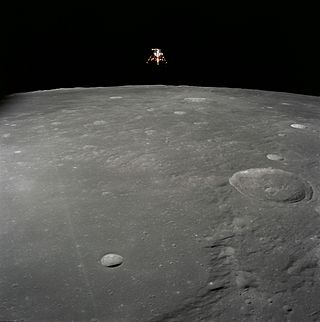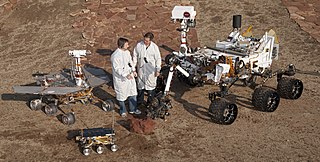
The Surveyor program was a NASA program that, from June 1966 through January 1968, sent seven robotic spacecraft to the surface of the Moon. Its primary goal was to demonstrate the feasibility of soft landings on the Moon. The Surveyor craft were the first American spacecraft to achieve soft landing on an extraterrestrial body. The missions called for the craft to travel directly to the Moon on an impact trajectory, a journey that lasted 63 to 65 hours, and ended with a deceleration of just over three minutes to a soft landing.

The Luna programme, occasionally called Lunik by western media, was a series of robotic spacecraft missions sent to the Moon by the Soviet Union between 1959 and 1976. The programme accomplished many firsts in space exploration, including first flyby of the Moon, first impact of the Moon and first photos of the far side of the Moon. Each mission was designed as either an orbiter or lander. They also performed many experiments, studying the Moon's chemical composition, gravity, temperature, and radiation.

Luna 15 was a robotic space mission of the Soviet Luna programme, that was in lunar orbit together with the Apollo 11 Command module Columbia.

Luna 16 was an uncrewed 1970 space mission, part of the Soviet Luna program. It was the first robotic probe to land on the Moon and return a sample of lunar soil to Earth. The 101 grams sample was returned from Mare Fecunditatis. It represented the first successful lunar sample return mission by the Soviet Union and was the third lunar sample return mission overall.

Luna 24 was a robotic probe of the Soviet Union's Luna programme. The 24th mission of the Luna series of spacecraft, the mission of the Luna 24 probe was the third Soviet mission to return lunar soil samples from the Moon. The probe landed in Mare Crisium. The mission returned 170.1 g (6.00 oz) of lunar samples to the Earth on 22 August 1976.

The Apollo Lunar Module, originally designated the Lunar Excursion Module (LEM), was the lunar lander spacecraft that was flown between lunar orbit and the Moon's surface during the United States' Apollo program. It was the first crewed spacecraft to operate exclusively in the airless vacuum of space, and remains the only crewed vehicle to land anywhere beyond Earth.

A lander is a spacecraft that descends towards, then comes to rest on the surface of an astronomical body other than Earth. In contrast to an impact probe, which makes a hard landing that damages or destroys the probe upon reaching the surface, a lander makes a soft landing after which the probe remains functional.

The far side of the Moon is the lunar hemisphere that always faces away from Earth, opposite to the near side, because of synchronous rotation in the Moon's orbit. Compared to the near side, the far side's terrain is rugged, with a multitude of impact craters and relatively few flat and dark lunar maria ("seas"), giving it an appearance closer to other barren places in the Solar System such as Mercury and Callisto. It has one of the largest craters in the Solar System, the South Pole–Aitken basin. The hemisphere has sometimes been called the "dark side of the Moon", where "dark" means "unknown" instead of "lacking sunlight" – each location on the Moon experiences two weeks of sunlight while the opposite location experiences night.

A Moon landing or lunar landing is the arrival of a spacecraft on the surface of the Moon, including both crewed and robotic missions. The first human-made object to touch the Moon was Luna 2 in 1959.

A sample-return mission is a spacecraft mission to collect and return samples from an extraterrestrial location to Earth for analysis. Sample-return missions may bring back merely atoms and molecules or a deposit of complex compounds such as loose material and rocks. These samples may be obtained in a number of ways, such as soil and rock excavation or a collector array used for capturing particles of solar wind or cometary debris. Nonetheless, concerns have been raised that the return of such samples to planet Earth may endanger Earth itself.

The physical exploration of the Moon began when Luna 2, a space probe launched by the Soviet Union, made a deliberate impact on the surface of the Moon on September 14, 1959. Prior to that the only available means of exploration had been observation from Earth. The invention of the optical telescope brought about the first leap in the quality of lunar observations. Galileo Galilei is generally credited as the first person to use a telescope for astronomical purposes; having made his own telescope in 1609, the mountains and craters on the lunar surface were among his first observations using it.

The Chinese Lunar Exploration Program, also known as the Chang'e Project after the Chinese Moon goddess Chang'e, is an ongoing series of robotic Moon missions by the China National Space Administration (CNSA). The program encompasses lunar orbiters, landers, rovers and sample return spacecraft, launched using the Long March series of rockets. A human lunar landing component may have been added to the program, after China publicly announced crewed lunar landing plans by the year 2030 during a conference in July 2023.

The LK was a lunar module developed in the 1960s as a part of several Soviet crewed lunar programs. Its role was analogous to the American Apollo Lunar Module (LM). Three LK modules, of the T2K variant, were flown without crew in Earth orbit, but no LK ever reached the Moon. The development of the N1 launch vehicle required for the lunar flight suffered setbacks, and the first Moon landings were achieved by US astronauts on Apollo 11. As a result, having lost the Space Race, both the N1 and the LK programs were cancelled without any further development.

A rover is a planetary surface exploration device designed to move over the rough surface of a planet or other planetary mass celestial bodies. Some rovers have been designed as land vehicles to transport members of a human spaceflight crew; others have been partially or fully autonomous robots. Rovers are typically created to land on another planet via a lander-style spacecraft, tasked to collect information about the terrain, and to take crust samples such as dust, soil, rocks, and even liquids. They are essential tools in space exploration.

A lunar rover or Moon rover is a space exploration vehicle designed to move across the surface of the Moon. The Apollo program's Lunar Roving Vehicle was driven on the Moon by members of three American crews, Apollo 15, 16, and 17. Other rovers have been partially or fully autonomous robots, such as the Soviet Union's Lunokhods, Chinese Yutus, Indian Pragyan, and Japan's LEVs. Five countries have had operating rovers on the Moon: the Soviet Union, the United States, China, India, and Japan.

Chang'e 5 was the fifth lunar exploration mission in the Chinese Lunar Exploration Program of CNSA, and China's first lunar sample-return mission. Like its predecessors, the spacecraft is named after the Chinese moon goddess, Chang'e. It launched at 20:30 UTC on 23 November 2020, from Wenchang Spacecraft Launch Site on Hainan Island, landed on the Moon on 1 December 2020, collected ~1,731 g (61.1 oz) of lunar samples, and returned to the Earth at 17:59 UTC on 16 December 2020.

Chang'e 6 is a robotic lunar exploration mission by the China National Space Administration. As China's second sample return mission, it will attempt to obtain a sample of soil and rock from the far side of the Moon. Like its predecessors in the Chinese Lunar Exploration Program, the spacecraft is named after the Chinese Moon goddess Chang'e. It launched on 3 May 2024 and the mission is expected to last about 53 days.

















